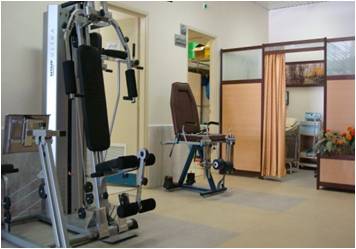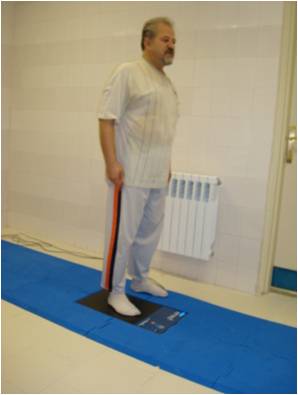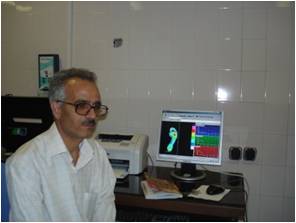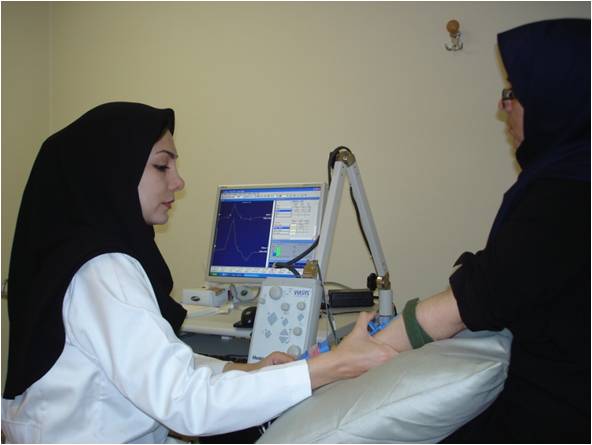| Cardiac Rehabilitation center: In this section, patients mainly after (CABG) bypass operation and IM and also valve change operation and suffering from heart conditions are directly or indirectly referred to. In case of CABG patients, which constitutes most of the patients of the ward, training phase of the rehabilitation of the heart starts about 6 weeks after the operation with exercising and the determination of the HR target by the cardiologist. The rehabilitation regime lasts 24 sessions, 3 times a week in groups of 6-8 individuals under the supervision of the physiopathologic physician and the competent staff for 45-60 minutes. |
 |
| 
|
| In each session, the patients do warm-up exercises while watching a video showing the exercises. This period is to prepare the body before the aerobic exercises. Then aerobic exercises are done for about 30 minutes with several modalities including bicycling, treadmill, and ergometer of the upper limbs. During the last 15 minutes in the cooling phase, mild stretching exercises are done to prevent hypotension and possible injuries. During the following weeks, the time and intensity of the aerobics can be increased with the ECG control and HR target. | 
|
| As rehabilitation practice is generally a group of actions and is not merely exercising and modality, in this part after the exercising, rehabilitative care and psychological and nutritional consultation are provided for the patients. The psychologist gives relaxation exercises including deep breathing, mild exercises, joint movements and even laughter exercise each session and then gives group consultation. Every 4 sessions s/he gives individual consultation. Group consultations concern the reduction of the tension and stress, overcoming every day stresses, prevention of depression and suitable adaptation to the social and occupational needs and changing the bad and harmful habit and living a healthy life style. In case of patients with special problems, individual consultation is given to them. |  |
| The nutritionist first studies the anthropometric and height and weight measurements and Body Composition Test of the patients using the related machine as shown in the following picture. This test measures being overweight, the amount of it, water percentage of the body, peritoneal and subcutaneous fat percentage, muscle mass, and the amount of the calorie consumed and needed. Should the need arise, biochemical tests are requested. In each session, a section is devoted to the training of the issues relating to the reduction of the fat, osteoporosis, diabetes, herbal medicine therapy, and hypertension issues are raised using pamphlets and pictures. At the end of the each session, Body Composition test and biochemical tests are repeated if necessary to monitor the patient recovery. | 
|
| EECP (Enhanced External Counterpulsion) center: A New modality which is established in this department is called EECP which stands for Enhanced External Counterpulsion. It means an antiangiogenic therapy in which the skin compressors are fitted outside the body to the thighs and ankles and then the compressors are inflated so that the blood returning toward the heart is increased. The timing of the compressors is regulated in a way that the increased blood stream is delivered exactly at the time of heart relaxation or diastole and this reduces the work load of the heart and commands the minimum demand of oxygen for the heart. |
 |  |
| In fact, by strengthening the collateral vessels around the blocked areas of the coronary vessels, the supply of heart oxygen is increased and a natural bypass is formed. Several studies have analyzed the benefits of this: |
| - reduction in angina pectoris - lesser need to nitroglycerin - faster recovery and returning to the social life with a high productivity This machine can also be used in cases of congestive heart failure, hypertension, cardiomyopathy, diabetic neuropathy, stroke, erection disorders, edema, vascular disorders, fatigue, and finally an increase in the performance of the athletes. |
| Physiotherapy and Occupational Therapy center: This section includes 8 out-patient beds to provide routine physical therapy equipped with modalities such as deep and surface thermotherapy including IR, HP, US and electrical stimulation including ES, TENS, cervical vertebrae traction and mechanotherapy agents, biofeedback machine, hydrotherapy, parallel bar and different exercises of occupational therapy after operations, and also a body building set for Functional Rehabilitation as shown in the following picture used for strengthening the different muscles of the body including stomach muscles, pectoral, shoulder, and femur and lower limbs pressing.  |
Furthermore, there is newly installed equipment besides these agents called isokinetic which is used for rehabilitation of orthopedic operations like repairing the ACL and PCL ligaments, joint problems, specially for the professional athletes and other joints with a special movement span.
All these services are available in the morning and afternoon shifts provided by the academic staff and competent non-academic staff. | Feet Scan: A new facility available now in this section is the Feet Scan agent which is sensitive to high pressure areas of the feet and shows the first excessive pressure and demonstrates the pathologic pressure while in standing position and then shows the first weight tolerance in the standing position and also movement. In cases of diabetic injuries of the foot, backache and so on, it helps show the direction of the high pressure areas arthritic prescriptions to relieve the pressure on the injuries and lesions. |
  |
|
Electrodiagnosis center: Finally, in another section of this department there are electrodiagnosis tests including neuron guidance and electromyography (EMG – NCS) to diagnose neuroscaler conditions including neuropathy, radioculopathy, myopathy, and neuron mutilation for the patients who refer or are referred to the department. | |
 |
| |
| |